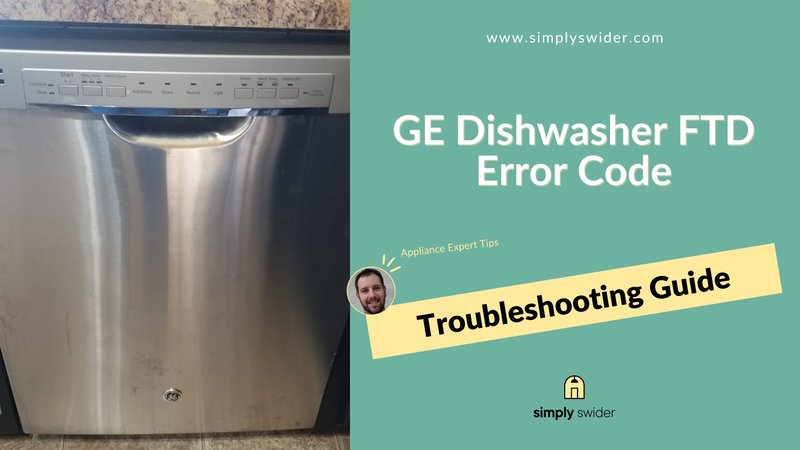
When you see the F1 error code flashing on your GE dishwasher, it can feel like your machine is speaking a language you can’t quite decipher. Think of it like your dishwasher sending out a distress signal. The F1 error typically means there’s an issue with water flow—imagine water trying to flow through a blocked pipe. This can be due to a few different reasons, from clogs in the filter to problems with the water inlet valve. While some folks might feel comfortable tinkering with these issues on their own, others might find it a bit daunting. Let’s dig a little deeper to see what this F1 code really means and when to pick up the phone for professional help.
Understanding the F1 Error Code
So, what exactly is this F1 error code, and why should you care? Well, understanding this code can be the key to saving both time and money. In GE dishwashers, the F1 error code generally pops up as a sign of a water flow issue. Imagine turning on a garden hose that’s kinked up; the water just can’t move through properly. This is a bit like what’s going on with your dishwasher when F1 appears.
Water flow problems can arise from several culprits. Perhaps the filter is clogged with food particles or debris, similar to a lint trap full of clothes. When this happens, the water can’t circulate as it should, causing the dishwasher to flash that ominous F1 code. Other times, it might be a faulty water inlet valve—it’s like a gate that opens up to let water in, and if it’s stuck, you’re out of luck.
You might be wondering if you can handle these issues on your own. For some homeowners, a quick clean of the filter might be all it takes to set things right. But if these simple solutions don’t do the trick, or if you start feeling overwhelmed, it’s probably time to think about getting some professional help.
When DIY Fixes Might Be Enough
If you’re a bit of a DIY enthusiast, you might be inclined to try your hand at fixing this pesky error code yourself. And sometimes, that can actually work! For instance, if the issue is with a clogged filter, you only need to remove it, give it a good rinse, and put it back in place—sort of like cleaning out a coffee filter to make sure nothing’s obstructing the flow.
Another straightforward fix might be checking the spray arms inside the dishwasher. They can get clogged just like a showerhead, and cleaning them might get your machine back in working order. You might also consider inspecting the water inlet valve. If it looks like it’s seen better days, it might be time for a replacement, which can be more complicated and may require a bit more technical skills or tools.
However, if you’ve tried these steps and that pesky F1 code is still there, don’t worry. Sometimes, even the best DIY efforts can’t solve everything, and that’s perfectly fine. At this point, calling a technician could be the best course of action.
Signs It’s Time to Call a Technician
You’ve tinkered, cleaned, and inspected, yet F1 still looms. When is it time to bring in the professionals? Here’s the deal: if your dishwasher keeps displaying the F1 error despite your best efforts, it might be facing a deeper mechanical issue that requires an expert’s touch. Think of it as needing a specialist when your car won’t start after checking the obvious—sometimes, expert advice is just necessary.
Persistent water supply issues could hint at a more serious problem with your dishwasher’s plumbing connections, something best handled by someone with experience. Similarly, if you suspect the internal wiring or electronics might be at fault—say the controls aren’t responding correctly—it’s time for a professional diagnosis.
Moreover, if you’re at wit’s end and just not comfortable dealing with the electrical and plumbing intricacies, don’t hesitate to call a technician. They have the right tools and expertise to safely and efficiently get your dishwasher back on track.
Preventive Tips for Future Errors
To keep that annoying F1 code at bay, regular maintenance can make a world of difference. Just like you wouldn’t let dust build up on your favorite bookshelf, a little routine care can keep your dishwasher running smoothly and error-free. Start by ensuring your dishwasher is free from food debris after each cycle. Think of it like wiping down counters to prevent buildup.
Inspect the spray arms and clean them routinely. This can prevent blockages, much like cleaning a showerhead to maintain water flow. Checking the water inlet valve periodically is also a good idea—ensuring it’s not worn out or malfunctioning can prevent a lot of headaches.
Lastly, don’t overload your dishwasher. Imagine stuffing too many clothes into a washing machine; not only can it affect performance, but it can also strain the machine. Give your dishwasher some breathing room with each load, and it’ll be less likely to throw an error your way. With these preventive steps and a bit of diligence, you can reduce the chances of seeing that dreaded F1 code anytime soon.
In summary, while some dishwasher issues are manageable with a little elbow grease, others require professional intervention. Don’t let an F1 error code cause panic—it’s often a solvable problem. Whether you prefer to DIY or call in the cavalry, keeping your dishwasher happy is just a matter of knowing when to act and how to maintain it.